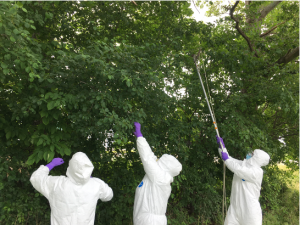Shedding light on browntail moths
Written by Rachel Jalbert, OneHealth REU program 2022 participant

Bugs…a very controversial organism; most people have very passionate feelings toward them. Typically you either love them or hate them. There are definitely bugs that insect lovers hate though…This summer I have been working in the forest entomology lab with Dr. Angela Mech and her graduate students. The primary species we are studying is browntail moth (BTM). BTM is one of those insects that not even insect fans love. An invasive species is a species that has potential to or has negatively impacted the economy, environment, or public; BTM just happens to check all of those boxes.
Introduced in the 1890’s, they spread across New England but eventually their populations were primarily established in Maine and Cape Cod, Massachusetts. The caterpillars are the most detrimental life stage since they feed primarily on hardwoods and have toxic hairs that cause poison-ivy-like rashes. The hairs of the caterpillar can go airborne, meaning that only you do not have to directly interact with the caterpillar to get the rash. These life stages are when the toxic hairs are the most abundant (allowing our lab to have fun with tyvek suits and lots of gloves).

Approximately during early to mid June the caterpillars begin to pupate, meaning they will soon become full fledged moths; moths are the adult stage of the species. Anecdotally I’m sure you’ve seen moths (of any species) attracted to some sort of source of light, this phenomenon is known as positive phototaxis.This is where my research comes into play.
My research is hoping to learn more about BTM’s attraction to light and whether there is a light bulb that they are the least attracted to. The implications of this would allow moth breeding grounds to be less centralized near public spaces or homes. The approach I am taking is making a cardboard contraption to emulate a light choice experiment.
Through conducting research, I’ve learned how to think quickly on my feet as well as unconventional problem solving skills. One of the great things about hands-on learning and research is that there is always something to discover. Since BTM has very little research regarding their behavior in introduced locations, it feels like everyday there is some new information or challenge to overcome.
